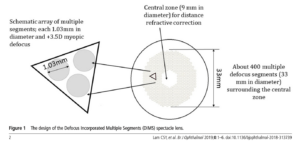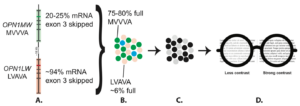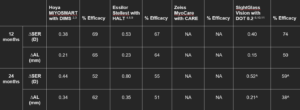October 2, 2023
By Nabin Paudel, BOptom, PhD
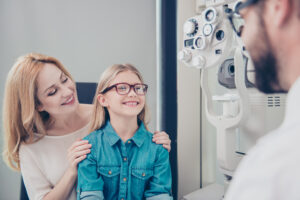
Myopia management using optical interventions, particularly spectacle lenses, has evolved over the past few decades as our understanding of myopia pathogenesis has improved. Initial attempts at slowing myopia progression with under-corrected single vision (SV) lenses, bifocal lenses, and progressive addition lenses showed limited success.1 However, emerging spectacle designs have demonstrated promising results. This article discusses the design and efficacy of next-generation spectacle lenses, provides some practical recommendations for clinical practice, and suggests areas for further research.
Next-Generation Spectacle Lens Designs*
Hoya MiYOSMART with Defocus Incorporated Multiple Segments (DIMS) Technology2
The DIMS lens consists of a central zone (9mm diameter) correcting distance vision surrounded by honeycomb-like multiple segments (33mm diameter) providing +3.50D adds, which introduce controlled myopic blur on the peripheral retina.
Essilor Stellest with Highly Aspherical Lenslet Target (HALT) Technology4
The HALT technology has an array of lenslets in the periphery. This lens includes a spherical front surface with 11 concentric rings formed by 1,021 contiguous aspherical lenslets (diameter of 1.1 mm). The central area of the lens without lenslets and the areas in between the rings of lenslets provides distance correction. The arrangement of aspherical lenslets has been designed to generate a Volume of Myopic Defocus (VoMD) in front of the retina at any eccentricity that serves as a myopia stop signal.
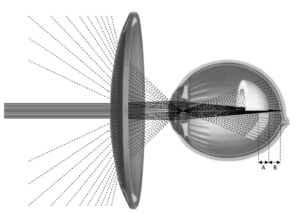
Illustration of the study device providing a volume of myopic defocus (VoMD) (white shell) in front of the retina through 11 concentric rings of contiguous lenslets (A=depth of VoMD and B=distance from the retina).4
Zeiss MyoCare with Cylindrical Annular Refractive Elements (CARE) Technology5
CARE technology consists of alternating defocus and correction zones in a ring-like pattern on the front lens surface, expanding towards the periphery of the lens. By creating a blur effect as part of simultaneous competing defocus, the microstructures deliver a “stop signal” to slow the progression of axial elongation.
CARE technology offers an “age-related myopia management lens solution.” This involves two distinct designs: one for children under the age of 10 (7 mm diameter central clear zone, mean additional surface power +4.60D, fill factor 0.5), and another for children aged 10 years and older (9 mm diameter central clear zone, mean additional surface power +3.80D, fill factor 0.5).
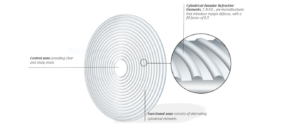
Source: www.zeiss.com/vision-care/en/newsroom/articles/myopia-causes-treatment-and-intervention-options.html
CARE technology features a lens design consisting of a central clear zone for vision correction and a surrounding functional zone incorporating alternating segments of addition power elements.
SightGlass Vision with Diffusion Optics Technology (DOT)6
Unlike the designs mentioned above, the DOT 0.2 lens does not have lenslets but diffusers aimed to scatter light in the peripheral retina. These diffusers are small dot-shaped elements placed across the lens periphery except in the central 5mm aperture that provides sharp and clear vision.
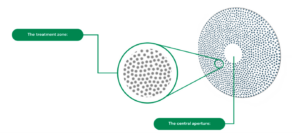
Source: DOT White Paper 2023
The DIMS, HALT, and CARE lenses, also known as peripheral plus spectacle lenses, aim to reduce peripheral hyperopic defocus, whereas the DOT lenses aim to address the abnormal contrast signaling in the myopic retina. Peripheral hyperopic defocus and abnormal cone contrast signaling in the retina are two hypothesized mechanisms for myopia progression.7
Efficacy
The table below presents the mean adjusted efficacy of various myopia control spectacle design lenses compared to single-vision spectacle lenses. The data is based on the published (peer-reviewed publications, conference abstracts) literature.
What Have We Learned So Far?
Based on the current evidence, several innovative spectacle lenses show promise in reducing the SER and axial length progression in juvenile-onset myopes, although results vary slightly across lens designs. To date, the DIMS technology has been the most extensively studied lens, with data available for up to six years.12 The study reporting the six-year data of the DIMS lens indicated no rebound effect after cessation of the treatment, and myopia control was maintained throughout the entire six-year study period. The DIMS lens has also been studied in European children and adolescents and has demonstrated similar efficacy.13
The HALT technology has also been extensively studied, with data available for up to four years.14 Another study of HALT technology spectacle lenses concluded that they were effective in slowing myopia, and the data did not indicate rebound of myopia upon discontinuation.15
Regarding side effects, none of the published studies reported any serious adverse events associated with using these next-generation spectacle lenses. However, with regard to the quality of vision, some studies have reported a slight decrease in contrast sensitivity and visual acuity when viewed through the treatment zones of the lenses.2,16-18
Considerations for Clinical Practice and Future Research
While next-generation spectacle lens designs have demonstrated encouraging results in controlling myopia progression, it is important for clinicians to understand some practical considerations to make informed decisions for their patients. First, most clinical trials that study the effectiveness of these lenses have been conducted in China. Therefore, the efficacy of these lenses in myopic children in other regions is still being studied. However, some authors argue that the efficacy of myopia control intervention is independent of race.19 Second, the long-term efficacy and rebound effects of these lenses are uncertain due to short study durations for most of the designs. This provides limited evidence as to when to stop or modify myopia control interventions. Third, studies commonly report the efficacy of myopia control interventions as percentages, although there is an ongoing debate about the appropriateness of using percentages as a measure of efficacy. This is because studies are not directly comparable due to inherent differences in the characteristics of the control groups, such as age and ethnicity, as well as variations in study duration and wear time. Reporting efficacy with the CARE metric (Cumulative Absolute Reduction in Axial Elongation) may be a more accurate method.20
It is important to note that efficacy is highly correlated with wear time. Children must wear each of these next-generation spectacle lens designs at least 12 hours every day and not remove them during near work to achieve maximum efficacy.8
Future research should focus on developing new innovative spectacle lens designs, optimizing current designs, conducting long-term studies on existing designs across diverse populations, and conducting combination therapy studies. These efforts will help realize the full potential of the next-generation spectacle lenses for myopia management.
References:
* None of these next-generation spectacle lenses are FDA approved or available in the U.S.
- Lawrenson, J. G., Shah, R., Huntjens, B., Downie, L. E., Virgili, G., Dhakal, R., … & Walline, J. J. (2023). Interventions for myopia control in children: a living systematic review and network meta‐analysis. Cochrane Database of Systematic Reviews, (2).
- Lam, C. S. Y., Tang, W. C., Tse, D. Y. Y., Lee, R. P. K., Chun, R. K. M., Hasegawa, K., … & To, C. H. (2020). Defocus Incorporated Multiple Segments (DIMS) spectacle lenses slow myopia progression: a 2-year randomised clinical trial. British Journal of Ophthalmology, 104(3), 363-368.
- Lam, C. S., Tang, W. C., Lee, P. H., Zhang, H. Y., Qi, H., Hasegawa, K., & To, C. H. (2022). Myopia control effect of defocus incorporated multiple segments (DIMS) spectacle lens in Chinese children: results of a 3-year follow-up study. British Journal of Ophthalmology, 106(8), 1110-1114.
- Bao, J., Yang, A., Huang, Y., Li, X., Pan, Y., Ding, C., … & Chen, H. (2022). One-year myopia control efficacy of spectacle lenses with aspherical lenslets. British Journal of Ophthalmology, 106(8), 1171-1176.
- Liu, X., Wang, P., Xie, Z., Sun, M., Chen, M., Wang, J., … & Mao, X. (2023). One‐year myopia control efficacy of cylindrical annular refractive element spectacle lenses. Acta Ophthalmologica, 101(6):651-657.
- Rappon, J., Chung, C., Young, G., Hunt, C., Neitz, J., Neitz, M., & Chalberg, T. (2022). Control of myopia using diffusion optics spectacle lenses: 12-month results of a randomised controlled, efficacy and safety study (CYPRESS). British Journal of Ophthalmology.
- Troilo, D., Smith, E. L., Nickla, D. L., Ashby, R., Tkatchenko, A. V., Ostrin, L. A., … & Jones, L. (2019). IMI–Report on experimental models of emmetropization and myopia. Investigative ophthalmology & visual science, 60(3), M31-M88.
- Bao, J., Huang, Y., Li, X., Yang, A., Zhou, F., Wu, J., … & Chen, H. (2022). Spectacle lenses with aspherical lenslets for myopia control vs single-vision spectacle lenses: a randomized clinical trial. JAMA ophthalmology, 140(5), 472-478.
- Li, X., Huang, Y., Yin, Z., Liu, C., Zhang, S., Yang, A., … & Bao, J. (2023). Myopia Control Efficacy of Spectacle Lenses with Aspherical Lenslets: Results of a 3-year Follow-up Study. American Journal of Ophthalmology.
- Rappon, J., Neitz, J., Neitz, M., Chung, C., & Chalberg, T. W. (2022). Two-year effectiveness of a novel myopia management spectacle lens with full-time wearers. Investigative Ophthalmology & Visual Science, 63(7), 408-408.
- Chalberg, T., Laughton, D., Hill, J., Tasso, V., Young, G., Hunt, C., … & Neitz, M. (2023). Control of Myopia Using Diffusion Optics Spectacle Lenses: Efficacy and Safety Study (CYPRESS) 42-month results. Investigative Ophthalmology & Visual Science, 64(8), 5092-5092.
- Lam, C. S. Y., Tang, W. C., Zhang, H. Y., Lee, P. H., Tse, D. Y. Y., Qi, H., … & To, C. H. (2023). Long-term myopia control effect and safety in children wearing DIMS spectacle lenses for 6 years. Scientific Reports, 13(1), 5475.
- Nucci, P., Lembo, A., Schiavetti, I., Shah, R., Edgar, D. F., & Evans, B. J. W. (2023). A comparison of myopia control in European children and adolescents with defocus incorporated multiple segments (DIMS) spectacles, atropine, and combined DIMS/atropine. PLoS One, 18(2), e0281816.
- Drobe, B., Xue, L., Huang, Y., Lim, E. W., & Bao, J. (2023). Spectacle lenses with highly aspherical lenslets for myopia control: 4-year clinical trial results. Investigative Ophthalmology & Visual Science, 64(8), 4162-4162.
- Sankaridurg, P., Weng, R., Tran, H., Spiegel, D. P., Drobe, B., Ha, T., … & Naduvilath, T. (2023). Spectacle Lenses With Highly Aspherical Lenslets for Slowing Myopia: A Randomized, Double-Blind, Cross-Over Clinical Trial: Parts of these data were presented as a poster at the Annual Research in Vision and Ophthalmology meeting, 2022. American Journal of Ophthalmology, 247, 18-24.
- Kaymak, H., Neller, K., Schütz, S., Graff, B., Sickenberger, W., Langenbucher, A., … & Schwahn, H. (2022). Vision tests on spectacle lenses and contact lenses for optical myopia correction: a pilot study. BMJ Open Ophthalmology, 7(1), e000971.
- Lu, Y., Lin, Z., Wen, L., Gao, W., Pan, L., Li, X., … & Lan, W. (2020). The adaptation and acceptance of defocus incorporated multiple segment lens for Chinese children. American journal of ophthalmology, 211, 207-216.
- Li, X., Ding, C., Li, Y., Lim, E. W., Gao, Y., Fermigier, B., … & Bao, J. (2021). Influence of lenslet configuration on short-term visual performance in myopia control spectacle lenses. Frontiers in Neuroscience, 15, 667329.
- Bullimore, M. A., & Brennan, N. A. (2023). Efficacy in Myopia control: Does race matter?. Optometry and Vision Science, 100(1), 5-8.
- Brennan, N. A., Toubouti, Y. M., Cheng, X., & Bullimore, M. A. (2021). Efficacy in myopia control. Progress in retinal and eye research, 83, 100923


